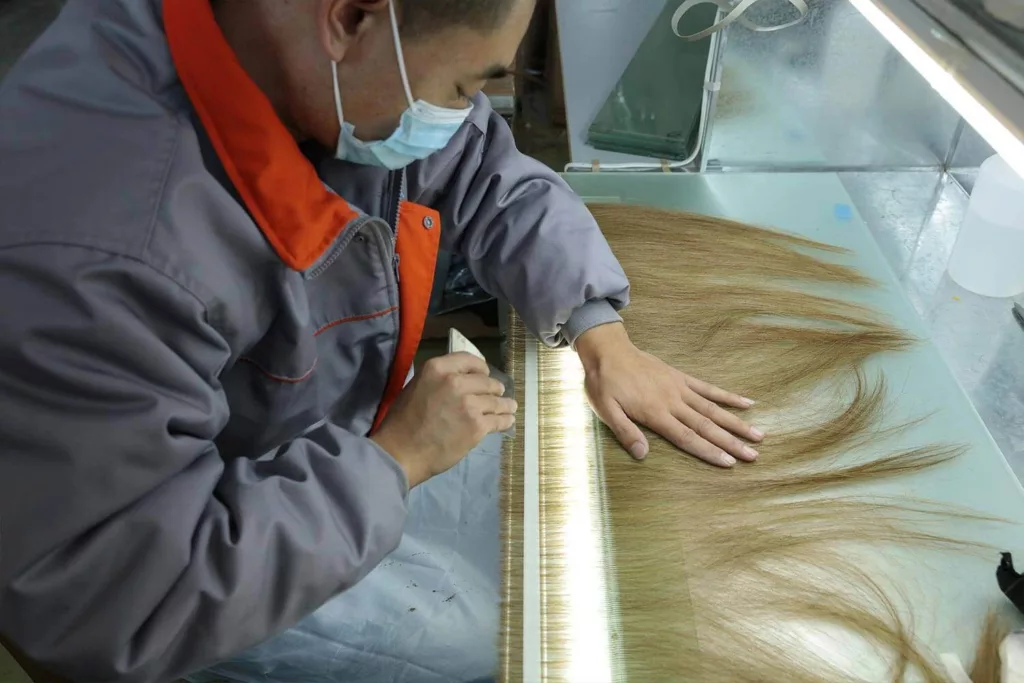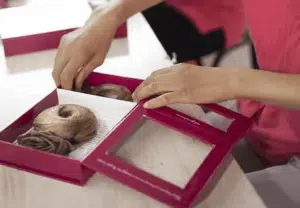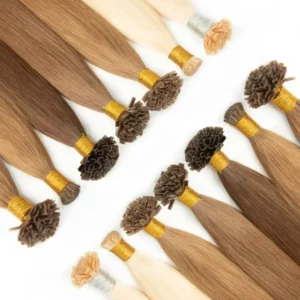You ask for fewer slips, faster installs, and hair that still looks soft at week eight. I hear you. The answer starts with honest raw hair and serious adhesive.
The best tape-in hair extensions use full cuticle, single-donor human hair and medical-grade tape,it’s named full cuticle tape in hair. Choose the right construction—regular, micro, invisible, or long tape weft—based on density and styling goals, then install with clean sections and even tension.

You do not need guesswork. I will walk through hair quality, tape chemistry, and construction. Then I will map each pro type with install notes, pros and cons, and ideal clients.
What Are Best Quality Tape Hair Extensions?
Full cuticle tape in hair is the best quality tape in hair extensions in current market.
What Are Full Cuticle Tape-In Hair Extensions?
For those entering the world of hair extensions, the terminology can be daunting. But rest assured, Full Cuticle Tape-In Hair Extensions are worth the investment.
Definition:Full Cuticle Tape-In Hair Extensions are made from human hair with the cuticle layer fully intact. This preservation ensures the hair maintains its natural shine, texture, and longevity, standing apart from chemically treated alternatives.
Why ‘Cuticle’?:The cuticle is the hair’s outermost layer, acting as a protective barrier. Keeping this layer intact means the hair stays smooth, tangle-free, and naturally shiny. Cheaper extensions often strip this layer, leading to dull and easily tangled hair.
Difference from Other Extensions:Full Cuticle Tape-In Hair Extensions are untreated, retaining their natural state. Most other extensions undergo chemical treatments, compromising their quality. Full Cuticle Hair offers a genuine look and feel, perfect for high-end clients seeking the best.
Ideal For:These extensions are ideal for clients looking for high-quality, long-lasting, and natural-looking hair. Though they come at a premium price, their durability and natural beauty make them a wise investment.

Why Full Cuticle Tape-In Hair Extensions are the best quality tape hair
High performance begins with raw hair. Full cuticle hair keeps the protective cuticle layer intact and aligned from root to tip. The strands glide. They resist tangles. They take tone more evenly. Single-donor ponytails keep texture and porosity consistent across each pack. I do not rely on acid baths or heavy silicone to fake slip. Those quick fixes look shiny for a few weeks, then the surface breaks down and the hair turns dry.
Tape matters as much as fiber. Medical-grade tapes from the USA or Germany balance peel strength and clean removal. The carrier film stays flexible under heat tools. The adhesive resists sweat, sebum, and minerals in hard water. It should let go with the right remover without tearing natural hair. I read numbers: shear strength, peel strength, and temperature range. I also smell for harsh solvents. Good tape is skin-safe and low-odor.
Build quality ties it together. Panel density should be even from top to tip. The top seam should be flat and sealed. The return hair (mustache) should be controlled so the root feels smooth. Color must be true to swatch. Cool blacks should not shift green. Blondes should be lifted gently to protect cuticles. Balayage and rooted blends should use injection or veil methods at the top for a soft, invisible finish.
| Factor | What “best” looks like | What to avoid |
|---|---|---|
| Hair source | Full cuticle, single donor, aligned | Mixed salon-floor hair, heavy silicone |
| Processing | No acid bath, gentle toning | Harsh bleaching, plastic shine |
| Tape | Medical-grade USA/DE, lab-tested | Unbranded adhesive, strong solvent smell |
| Panel build | Flat top, sealed edges | Bulky top, fraying edges |
| QC | Stable grams and shade per batch | Weight swing, color drift |

Types of Best Professional Tape In Hair Extensions?
Not every head needs the same panel. Matching construction to density, lifestyle, and styling plans reduces tension, improves comfort, and keeps bonds hidden. Here is a deep look at the four pro families I build and supply most: Regular Tape-In, Micro Tape-In, Invisible Tape-In, and Long Tape Weft / Invisible Tape Weft.
Regular Tape-In Hair Extensions

Definition: Two flat panels of full cuticle hair sandwich a thin slice of natural hair. Width is usually 3–4 cm. Weight per panel ranges from 2.0–2.5 g for standard lines.
Install method: Clean, dry roots. Clarify and blow dry smooth. Part thin, even slices—thinner than the tape. Place the bottom panel adhesive up, lay the slice, then press the top panel adhesive down in perfect alignment. Leave 2–3 mm from scalp for movement. Press with silicone pliers for 5–10 seconds. Warm briefly with a low-heat pass through the hair (not on the glue) to seat the bond.
Pros: Fast mapping and install. Strong hold on normal to thicker hair. Cost-effective for full heads. Broad color availability and easy mixing with micro or invisible rows. Reliable 6–8 week wear on most clients.
Cons: Can be slightly visible on very fine hair near the part. Needs careful perimeter planning for tight ponytails. Heavier feel than micro panels in face-framing areas.
Best for: Medium density clients who want both length and volume, global transformations, and salons that value speed with stable hold.
Pro factory note: I seal edges with micro-stitch or resin to reduce shed. I target an even taper to avoid a heavy “ledge” at the ends.
Micro Tape-In Hair Extensions
Definition: Narrower, lighter panels. Common widths 1.5–2.5 cm. Weight per panel ~1.0–1.5 g. Same fiber and adhesive quality as regular, but scaled down for discreet placement.

Install method: Same surface prep as regular, but with finer sectioning and more panels. Great around the face, temples, nape, and crown. Use more rows with fewer panels per row to balance weight on delicate areas.
Pros: Very discreet. Gentle on fine or fragile hair due to lower weight per bond. Precise contouring around cowlicks and small head shapes. Great for blending layers and filling holes.
Cons: More panels mean longer install and removal. Inventory management is stricter because you track many small pieces. Cost per gram can be higher.
Best for: Fine density clients, small heads, lightweight volume, detailed blending near hairlines, post-partum hair recovery plans.
Pro factory note: I keep return hair ultra-short and aligned on micro panels to reduce scalp tickle and improve comfort.
Invisible Tape-In Hair Extensions
Definition: Panels with an injected or veiled top. Hairs appear to emerge from the tape, so the bond looks like scalp. The upper surface is matte and textured to kill shine under partings and bright light.
Install method: Prep as above. Use on top rows, around the crown, and any area exposed by high ponytails or center parts. Avoid tension twists during pressing. Align precisely; misalignment ruins the invisible effect. Mix with regular or micro panels on lower rows to control cost and speed.

Pros: Seamless visuals in partings, flips, and updos. Ideal for blondes and high-contrast roots where regular tops can show. Photographs very well. Premium feel that clients love.
Cons: Higher price due to complex top construction. Requires more precise placement and pressure. Some cheap invisible tops shed if edges are not sealed; quality matters.
Best for: Clients who wear high ponytails and half-ups. Stylists who need camera-ready parting lines. Blended balayage work where the top must disappear.
Pro factory note: I use soft-touch films and double-edge sealing. I test under harsh salon LEDs to ensure no glare or grid-line shows through.
Long Tape Weft and Invisible Tape Weft
Definition: A continuous pre-taped strip (often 20–30 cm or custom) instead of small panels. The invisible version uses injected/veiled tops across the strip. These build rows faster with fewer bond points.
Install method: Map the head like a weft row, but apply the strip in segments you pre-cut to fit the curve. Keep tension even across the arc. Press from center outward to avoid air pockets. Great for back sections where you want quick coverage. Use micro or invisible singles near edges to finish cleanly.
Pros: Speed. Fewer individual bonds. Very clean lines for global volume. Even weight distribution. Strong option for commercial work where time matters.
Cons: Needs skilled tension control along curves. Removal requires patient segment work. Not ideal for very small heads unless you pre-plan cuts. If you place too close to scalp curves, edges can lift.
Best for: High-volume salon days, uniform volume clients, photo or video production schedules, pros who want hybrid speed between tape-ins and weft rows.
Pro factory note: I ship long tape wefts with cut lines printed on the liner to help techs pre-size segments without fray or waste.

Side-by-side summary
| Type | Install time | Visibility | Weight per bond | Best zones | Cost level |
|---|---|---|---|---|---|
| Regular | Fast | Low–Medium | Medium | Back and mids | $$ |
| Micro | Medium | Very low | Low | Face, nape, crown | $$–$$$ |
| Invisible | Medium | Minimal | Medium–Low | Top rows, part lines | $$$ |
| Long/Invisible tape weft | Very fast | Low–Minimal | Distributed | Back rows | $$–$$$ |
High Production Standards of the Best Tape-In Hair Extensions
Raw Material: Full Cuticle Tape-In Hair is sourced from single donors, ensuring unmatched uniformity in texture, curl pattern, and color. This meticulous selection process guarantees the hair remains in its purest form, free from prior chemical treatments.
Processing Technique: The acid-free processing technique preserves the hair’s natural state, ensuring the cuticles remain intact. This method, mastered by only a few factories, delivers a superior product that stands out in terms of quality and longevity.
Adhesive Quality: Our tape-in hair extensions utilize high-quality white tape from the USA and blue tape from Germany. These adhesives meet international quality standards, ensuring durability and safety for all users. They are non-toxic and suitable for various customer needs, providing a secure and lasting hold.
Production Process: The standardized production process ensures consistency and uniformity across all batches of tape-in hair extensions. This meticulous approach guarantees that bulk orders meet the highest standards, fulfilling the requirements of wholesale clients who demand reliable and consistent products.
If you want to learn more about our production techniques, please contact us: https://hibiscushair.com/factory/

How Do I Judge Raw Hair vs. Tape Quality Together?
I test the pair as a system. First, I do a wet–dry–heat cycle: shampoo with sulfate-free, blow dry on medium, then pass an iron at 180–190°C with heat protectant. Good tape stays flat and clear. Poor tape goes cloudy, bubbles, or slides. Next, I oil mid-lengths lightly and check the bond edge. Stable edges do not turn milky or sticky.
For fiber checks, I comb from ends upward and feel for drag. Full cuticle hair detangles smoothly. I do a quick mineral challenge with a teaspoon of salt in warm water to mimic sweat and hard water; cheap toners bleed. I record targets: 6–8 weeks wear on normal scalps, 4–6 weeks on oily scalps or swimmers, and 2–4 retapes per set with clean removal. If a line cannot meet this under normal care, I do not stock it. The best tape in hair extensions clear these tests.

Are Tape-In Hair Extensions Easy to Install for Professionals?
Yes, with a consistent map and clean sections. Keep roots product-free. Dry fully. Take very thin slices—thinner than the tape—so adhesive bonds panel to panel. Hold 2–3 mm off the scalp for movement. Press with a silicone pad. Warm slightly through the hair to seat the bond. Stagger rows so bonds do not stack. Switch to micro on top rows and around the face. Use invisible at exposed partings. Trim panel length near crown to reduce weight and slip. Good installs come from simple, repeatable habits.
How Long Do the Best Tape-In Hair Extensions Last?
Move-ups: 6–8 weeks for most clients; 4–6 for oily scalps or athletes.
Fiber lifespan: 9–18 months with normal care; 18–24+ months with gentle heat, soft water, and careful brushing.
Retapes: 2–4 cycles per set when removal is clean and re-tape is fresh.
Teach clients to wash roots flat with sulfate-free shampoo, condition mid-lengths and ends only, and rough-dry bonds after each wash. Avoid oils and heavy masks near bonds. These small rules keep results stable.
How to Maintain and Care for Tape-In Hair Extensions
Maintaining Full Cuticle Tape-In Hair is essential to preserving its beauty and extending its lifespan. Here are key tips to keep these premium extensions in top condition:
Gentle Washing:Use a sulfate-free shampoo and lukewarm water to wash the extensions gently, applying the shampoo in a downward motion to prevent tangling.
Deep Conditioning:Conditioning is vital. Use a high-quality, silicone-free conditioner to nourish the hair, leaving it in for a few minutes before rinsing thoroughly. Regular salon visits for professional care are recommended.

Minimal Heat Styling:While Full Cuticle Hair can withstand heat, minimize the use of high-temperature tools. Always apply heat protectant spray before styling.
Avoid Harsh Chemicals:Avoid coloring, bleaching, or any chemical treatments. If necessary, consult a professional stylist experienced with high-quality extensions.
Regular Trimming:Regular trims prevent split ends and keep the hair looking fresh.
Proper Storage:Store the extensions properly when not in use. Hang them or store flat in a silk or satin bag to prevent tangling and damage.
Use a Soft Bristle Brush:Detangle using a soft bristle brush or wide-tooth comb, starting from the ends and working up to the roots.
By following these care tips, you can ensure your Full Cuticle Tape-In Hair extensions remain as stunning as the day you first wore them, providing lasting satisfaction to your clients.

My Opinion
I rank products by boring consistency, not hype. Full cuticle hair plus medical-grade tape always wins long term. Install goes smoother. Move-up is cleaner. Clients come back for color, not repairs. That is what “best” looks like in a busy pro room.
FAQ
Q: Which type should I pick for fine hair?
A: Micro panels on most rows, invisible on top lines. Keep weight low per bond and widen row count for balance.
Q: Do invisible tape-ins shed more?
A: Quality injected tops do not. Low-end copies can fray. Check edge sealing and do a gentle pull test before stocking.
Q: How many panels for a full head?
A: Fine density 30–40 panels (75–100 g). Medium 40–60 panels (100–150 g). Thick or long transformations 60–80 panels (150–200 g).
Q: Can clients swim or work out?
A: Yes. Braid before, rinse after, shampoo roots the same day, and dry bond areas. Expect shorter wear cycles for heavy swimmers.
Q: Can I color tape-ins?
A: Deposit-only toning is safe on full cuticle hair. Avoid bleach, especially near bonds. Always strand-test.
Q: What causes slips most?
A: Conditioner or oil on roots before install, sections that are too thick, and stacked bonds. Fix prep, section thickness, and mapping.
Q: Are long tape wefts faster for every head?
A: They are fastest in back sections on medium to large heads. Use micro or singles to finish tight curves and hairlines.
Q: How do I store re-taped panels?
A: Keep them flat, cool, and out of light. Use fresh liners. Replace tape if it gathers dust or loses tack.
Conclusion
Full Cuticle Tape-In Hair Extensions are the pinnacle of hair extensions, offering unmatched quality, longevity, and natural beauty. For professionals seeking to provide the best for their clients, these extensions are the ultimate choice. Invest in Full Cuticle Hair and elevate your business to new heights. Contact us today for the best Full Cuticle Tape-In Hair Extensions: Hibiscus Hair.





